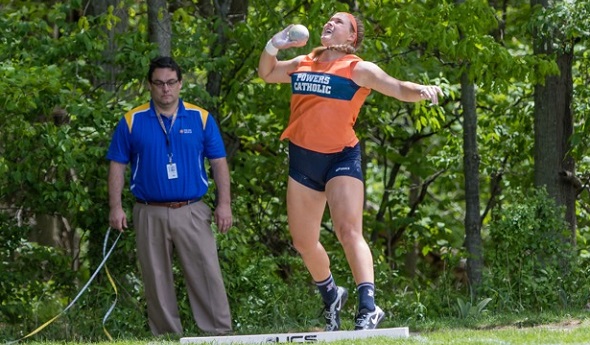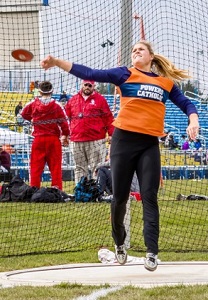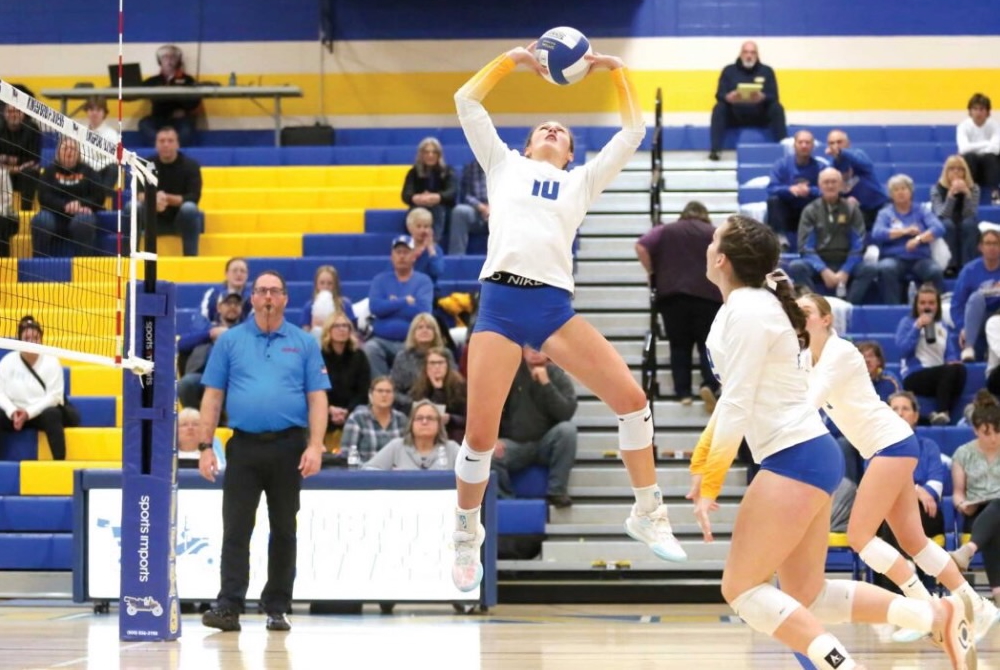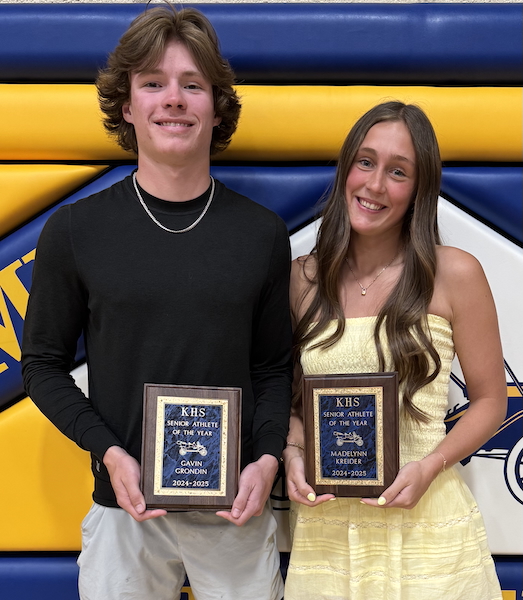
Sargent Takes Charge as Elite Thrower
April 22, 2016
By Bill Khan
Special for Second Half
FLINT — If Nikole Sargent decided early on to specialize in her favorite sport, she never would've discovered her best sport.
 Track and field, actually, ranked no higher than third on her list when she began competing in high school. She made the varsity volleyball team as a freshman at Linden in the fall of 2012, then made the Eagles' varsity basketball team in the winter.
Track and field, actually, ranked no higher than third on her list when she began competing in high school. She made the varsity volleyball team as a freshman at Linden in the fall of 2012, then made the Eagles' varsity basketball team in the winter.
"Basketball was the sport I thought I was going to go to in college," Sargent said. "Volleyball took over in my mind my sophomore year. I was going to play really high-level volleyball, so I gave up basketball and focused on track and volleyball."
Oh, yeah, track.
It's a good thing she kept that option open, because that's where she's really made a name for herself in high school and where she'll compete as a thrower for Michigan State University.
"My sophomore year, I got letters from schools about track," Sargent said. "I'm like, 'Oh, I never thought about this.'"
Sargent hit the radar of college track and field recruiters when she placed third as a freshman in the shot put in the 2013 MHSAA Lower Peninsula Division 2 meet for Linden with a toss of 41 feet, 1.5 inches. After transferring the following school year to her parents' alma mater, Flint Powers Catholic, she took second in the shot put (41-3) and 10th in the discus (109-4) in Division 3.
When Powers moved up to Division 2 her junior year, Sargent was unaffected by the increase in competition. She won the MHSAA championship in the shot put, throwing 45-4.75.
It was a performance that mirrored that of her father, Mike, who won the shot put and discus for Powers in 1984 after the Chargers moved up from Class B to Class A. He was third in both events in Class B as a junior in 1983.
Nikole was already involved in three sports by her middle school years when her father, a tight end on MSU's 1988 Rose Bowl team, introduced her to shot put.
At first, she was underwhelmed.
"When I first threw the shot put in seventh grade," Sargent said, "I was like, 'Oh, my gosh, this is not for me. This is hard. I am not going to be good at this.' Then I went to my first meet and I ended up beating everyone by like 10 or 15 feet. I was like, 'OK, I guess I'll give it a shot.' That's when he really started working with me and said, 'You could be good at this.'
"It was something completely different than anything I'd ever done. I was a basketball player, a volleyball player, a soccer player. I was not a thrower, in my mind. Not until eighth grade did I think of myself as a thrower."
 Sargent threw the six-pound shot 43-6 as an eighth grader. Her outdoor season bests throwing the 8.8-pound shot in high school have been 43-7.5 as a freshman, 42-6.5 as a sophomore, 45-6.25 as a junior and a school-record 47-0.75 as a senior.
Sargent threw the six-pound shot 43-6 as an eighth grader. Her outdoor season bests throwing the 8.8-pound shot in high school have been 43-7.5 as a freshman, 42-6.5 as a sophomore, 45-6.25 as a junior and a school-record 47-0.75 as a senior.
In the Michigan Indoor Track Series state meet on Feb. 27, Sargent won the championship with a throw of 45-9. She topped a field that included defending MHSAA LP Division 1 champion Emily Meier of Canton and two other top-five finishers from last year's Division 1 meet.
While she already has an MHSAA shot put title on her resume, Sargent is determined to atone for a subpar performance in the discus last season. She was the second seed in the discus last spring with a toss of 132-11, but wound up 12th at 111-3 at the MHSAA meet.
"I threw really bad, so I'm kind of out for redemption this year," Sargent said. "I know I can throw a lot better, and I'm hoping to take a state title in that, as well. My practices have already been 10 times better than last year. Disc is all form. Pretty much throughout this last summer and the beginning of this season, I've just been working on form. I work on my form for 10, 20, even 30 minutes before I start throwing.
"I came in seeded second. When you end up taking (12th), it's not really something good, but you learn from every experience. I try to be a stronger person. I don't let pride get in the way or anything. It just makes you want to work harder."
Sargent has developed consistency in the discus early this season, clearing 130 feet in all three of her competitions. She did so only twice in 2015, both throws coming late in the season.
Sargent not only has the benefit of her father's throwing knowledge, but she's coached by Mike Stuart, one of the most successful throwing coaches in Michigan. Flint Carman-Ainsworth had the premier throwing program in the state when Stuart was an assistant coach with the Cavaliers.
"It helps a lot," Sargent said. "Obviously, he's had so much success. Working with him has brought this whole new world of throwing to me that I never imagined. He has a way of putting things that makes so much sense to me."
Stuart began working with Sargent before her junior year.
"She needed a lot of help," Stuart said. "I had to reteach her the discus the first summer that I met her. Her shot put technique was basically good; we just had to work on using the circle better. She has a 45-foot standing throw, which is off the charts. I've never even heard of that in high school. It's from having basic good throwing technique, and she's awfully strong for a girl; she bench-presses 210 pounds."
If Sargent needs advice on how to deal with the ups and downs of an athletic career, she doesn't have to look beyond the family dinner table.
In addition to her father's athletic background, twin brother Noah was the starting quarterback on Powers' MHSAA Division 5 runner-up football team in the fall and older sister Jordan is a defender on Oakland University's soccer team.
"My mom (Tracy) played sports, as well," Sargent said. "We grew up working out together. We were always watching a football game. Sports has always been a big part of my life. My twin brother and I have always competed against each other, even though we do different sports. We've always been that rival with each other. 'I'll shoot baskets with you if you'll toss the volleyball.'"
An accomplished athlete in her own right, Nikole relished taking on the role of cheerleader when her brother led Powers to Ford Field.
"I was the leader of our student section," she said. "I started all the cheers. I was always in the front row. That was an amazing memory."
 Bill Khan served as a sportswriter at The Flint Journal from 1981-2011 and currently contributes to the State Champs! Sports Network. He can be reached at [email protected] with story ideas for Genesee, Lapeer, St. Clair, Sanilac, Huron, Tuscola, Saginaw, Bay, Arenac, Midland and Gladwin counties.
Bill Khan served as a sportswriter at The Flint Journal from 1981-2011 and currently contributes to the State Champs! Sports Network. He can be reached at [email protected] with story ideas for Genesee, Lapeer, St. Clair, Sanilac, Huron, Tuscola, Saginaw, Bay, Arenac, Midland and Gladwin counties.
PHOTOS: (Top) Flint Powers' Nikole Sargent unloads the shot during a meet last season. (Middle) Sargent tosses the discus during the Earlybird meet at Flint Kearsley on April 13. (Photos courtesy of the Sargent family and Flint Powers athletic department.)

Kingsford's Kreider Prepared for Next Level After Finishing Stellar Flivvers Career
By
John Vrancic
Special for MHSAA.com
June 19, 2025
KINGSFORD — After completing a successful high school volleyball career, Maddy Kreider is ready to take the next step.
 The Kingsford senior is taking her talents to Michigan Tech, where she’s expected to continue primarily as a setter.
The Kingsford senior is taking her talents to Michigan Tech, where she’s expected to continue primarily as a setter.
“That will be a big step for sure, but it’ll be exciting being with the girls,” she said. “The girls are taller in college. It will definitely be an adjustment, physically and mentally. We’ll be traveling longer distances, and it’ll be a matter of improving the mental part of my game.”
Kreider was selected the Upper Peninsula’s Defensive Player of the Year her final two seasons after the U.P. Sportswriters and Sportscasters Association began voting for all-U.P. volleyball.
“That’s quite an accomplishment,” she said. “It’s a real honor playing with girls I grew up with. We had a great season.”
The 5-foot-8 setter was a four-year starter and two-year team captain at Kingsford, leading the Flivvers to three Division 2 District titles and back-to-back undefeated Great Northern Conference championships. She twice was named GNC Player of the Year.
She was also selected all-state first team in the fall and all-state second team in 2023, and all-region throughout her prep career. Her serving percentage also topped .900 throughout her four seasons on varsity.
 Last fall, the Flivvers reached the Regional Semifinal at Manistique where they dropped a 3-2 decision to Kingsley.
Last fall, the Flivvers reached the Regional Semifinal at Manistique where they dropped a 3-2 decision to Kingsley.
“I thought we’d get through,” Kreider said. “We came out lights out in the first two sets, then it was close in the last three.”
Also among the team’s highlights this past fall was a victory at Calumet, approximately 2½ weeks after dropping a 3-1 decision to the Copper Kings on Kingsford’s home floor.
“We wanted to play them,” Kreider said. “They’re a great bunch of girls to play against. They’ve been the measuring stick up here for many years. Winning on their floor was super exciting. We knew we had to play well just to be competitive. That was a great confidence builder for our group. We were definitely on a high going into the District.”
The Flivvers opened their postseason with a 3-1 triumph over Houghton, then defeated Escanaba in straight sets in the District Final.
Kreider will join Calumet senior Maddie Torola at MTU this fall. Torola, who recorded a season-high 19 kills in the four-set victory at Kingsford, helped the Copper Kings finish 29-5 and reach the Division 3 Regional Final at Sault Ste. Marie where they dropped a 3-2 decision to Traverse City St. Francis.
“It was fun playing against her in high school,” Kreider said. “It will be even more fun playing as teammates. It’ll be exciting to be playing on the same team.”
Both will be playing under new head coach Cindy Pindral at Tech. Both of Kreider’s parents played for the Huskies, her mother (and Kingsford varsity coach) Jaclynn volleyball from 1998-2002 and her father Jason basketball from 1997-2000.
Maddy Kreider recently earned an additional honor when she was selected Female Athlete of the Year for Kingsford’s Class of 2025. She recently completed a solid track & field season for the Flivvers.
At the U.P. Division 1 Finals, Kreider placed fourth in the 100-meter dash (13.2) and anchored the Flivvers to a third-place finish in the 800 relay (1:51.57) and fourth in the 400 (53.03) on their home track.
Kreider was named one of 32 MHSAA/Farm Bureau Insurance Scholar-Athlete Award winners this winter and plans to study exercise science and kinesiology at MTU.
 John Vrancic has covered high school sports in the Upper Peninsula since joining the Escanaba Daily Press staff in 1985. He is known most prominently across the peninsula for his extensive coverage of cross country and track & field that frequently appears in newspapers from the Wisconsin border to Lake Huron. He received the James Trethewey Award for Distinguished Service in 2015 from the Upper Peninsula Sportswriters and Sportscasters Association.
John Vrancic has covered high school sports in the Upper Peninsula since joining the Escanaba Daily Press staff in 1985. He is known most prominently across the peninsula for his extensive coverage of cross country and track & field that frequently appears in newspapers from the Wisconsin border to Lake Huron. He received the James Trethewey Award for Distinguished Service in 2015 from the Upper Peninsula Sportswriters and Sportscasters Association.
PHOTOS (Top) Kingsford’s Maddy Kreider sets for her teammates during a match last season. (Middle) Kreider, right, takes a photo with Kingsford’s Male Athlete of the Year Gavin Grondin. (Photos provided by the Kingsford athletic department.)

